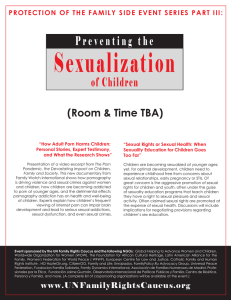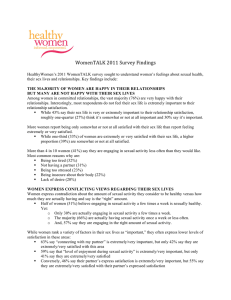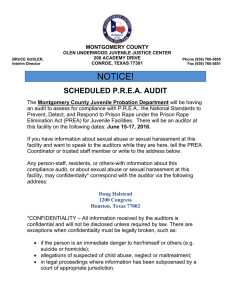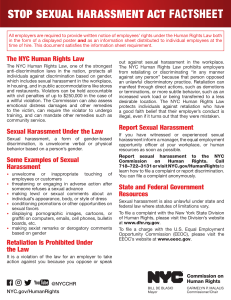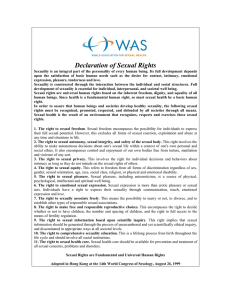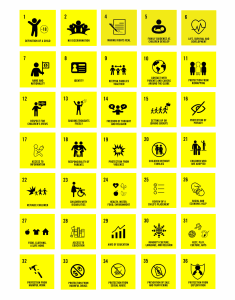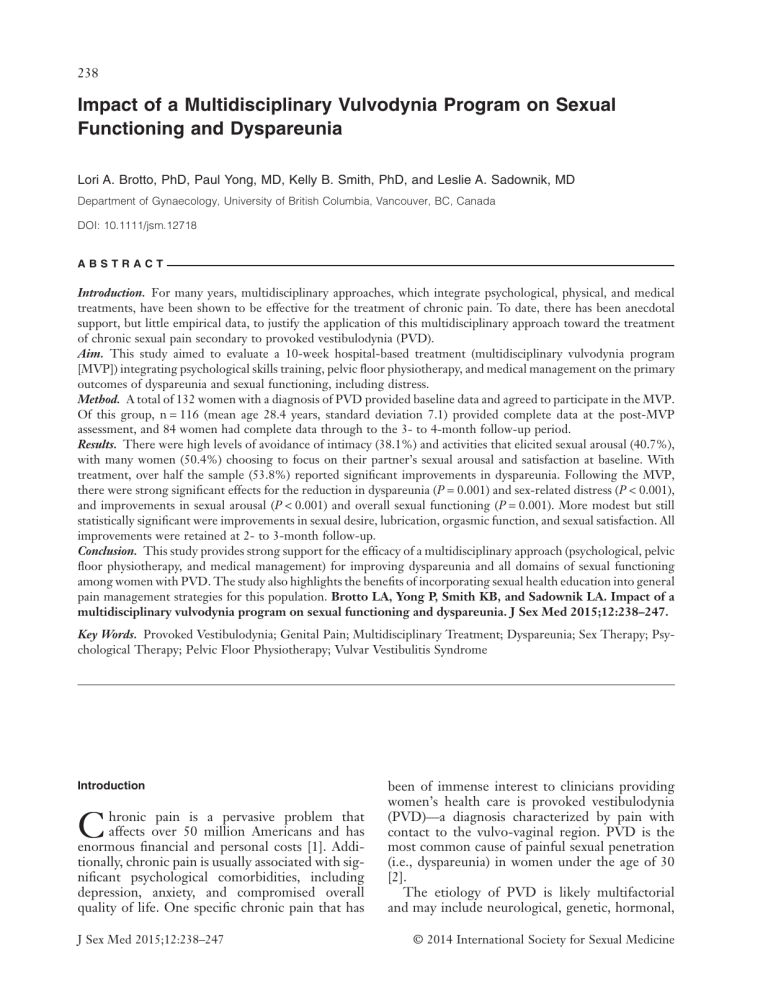
238 Impact of a Multidisciplinary Vulvodynia Program on Sexual Functioning and Dyspareunia Lori A. Brotto, PhD, Paul Yong, MD, Kelly B. Smith, PhD, and Leslie A. Sadownik, MD Department of Gynaecology, University of British Columbia, Vancouver, BC, Canada DOI: 10.1111/jsm.12718 ABSTRACT Introduction. For many years, multidisciplinary approaches, which integrate psychological, physical, and medical treatments, have been shown to be effective for the treatment of chronic pain. To date, there has been anecdotal support, but little empirical data, to justify the application of this multidisciplinary approach toward the treatment of chronic sexual pain secondary to provoked vestibulodynia (PVD). Aim. This study aimed to evaluate a 10-week hospital-based treatment (multidisciplinary vulvodynia program [MVP]) integrating psychological skills training, pelvic floor physiotherapy, and medical management on the primary outcomes of dyspareunia and sexual functioning, including distress. Method. A total of 132 women with a diagnosis of PVD provided baseline data and agreed to participate in the MVP. Of this group, n = 116 (mean age 28.4 years, standard deviation 7.1) provided complete data at the post-MVP assessment, and 84 women had complete data through to the 3- to 4-month follow-up period. Results. There were high levels of avoidance of intimacy (38.1%) and activities that elicited sexual arousal (40.7%), with many women (50.4%) choosing to focus on their partner’s sexual arousal and satisfaction at baseline. With treatment, over half the sample (53.8%) reported significant improvements in dyspareunia. Following the MVP, there were strong significant effects for the reduction in dyspareunia (P = 0.001) and sex-related distress (P < 0.001), and improvements in sexual arousal (P < 0.001) and overall sexual functioning (P = 0.001). More modest but still statistically significant were improvements in sexual desire, lubrication, orgasmic function, and sexual satisfaction. All improvements were retained at 2- to 3-month follow-up. Conclusion. This study provides strong support for the efficacy of a multidisciplinary approach (psychological, pelvic floor physiotherapy, and medical management) for improving dyspareunia and all domains of sexual functioning among women with PVD. The study also highlights the benefits of incorporating sexual health education into general pain management strategies for this population. Brotto LA, Yong P, Smith KB, and Sadownik LA. Impact of a multidisciplinary vulvodynia program on sexual functioning and dyspareunia. J Sex Med 2015;12:238–247. Key Words. Provoked Vestibulodynia; Genital Pain; Multidisciplinary Treatment; Dyspareunia; Sex Therapy; Psychological Therapy; Pelvic Floor Physiotherapy; Vulvar Vestibulitis Syndrome Introduction C hronic pain is a pervasive problem that affects over 50 million Americans and has enormous financial and personal costs [1]. Additionally, chronic pain is usually associated with significant psychological comorbidities, including depression, anxiety, and compromised overall quality of life. One specific chronic pain that has J Sex Med 2015;12:238–247 been of immense interest to clinicians providing women’s health care is provoked vestibulodynia (PVD)—a diagnosis characterized by pain with contact to the vulvo-vaginal region. PVD is the most common cause of painful sexual penetration (i.e., dyspareunia) in women under the age of 30 [2]. The etiology of PVD is likely multifactorial and may include neurological, genetic, hormonal, © 2014 International Society for Sexual Medicine 239 Multidisciplinary Treatment of Vulvodynia psychological, interpersonal, and muscular components [3]. The management of PVD is not straightforward, and a variety of medical, behavioral, and surgical treatment approaches have been tested [4,5]. Despite approximately 40 treatment outcome studies carried out over the past 15 years, it is still challenging for a clinician to identify an optimal treatment for an individual woman. Thus, most women with PVD will try many treatment modalities, often over the course of many years, before experiencing any significant relief [6]. Stemming, in part, from evidence that a biopsychosocial model of chronic pain is more appropriate than previously held dualistic views [7], there is strong support for the use of multidisciplinary and multimodal treatment in chronic pain [8]. Multidisciplinary treatment for genital pain is relatively new; however, there appears to be growing support for such an approach. Standard operating guidelines for the treatment of genital pain in women specifically identify a combination of education on pain management, pelvic floor physiotherapy, sex therapy, and medical approaches as ideally comprising the multidimensional approach [9]. For instance, women with PVD who engaged in individual psychosexual therapy with a counselor and pelvic floor physiotherapy with a midwife reported improvement in intercourse frequency, coital pain, and overall sexual functioning [4]. Among women with PVD who participated in a multidisciplinary program that included at least two self-selected treatments (medical, dietary change, individual psychotherapy, or physiotherapy), qualitative interviews revealed 27 of the 29 (93%) women reported a significant benefit, including 33% who reported complete resolution of their pain [10]. In both of these studies, the authors noted that a team approach to vulvodynia was responsible for patients’ improvement. Moreover, women reported feeling safe in the team environment and believed that the interventions complemented one another [4,10]. Despite these results, quantitative research with larger sample sizes is needed to support the efficacy of a multidisciplinary approach in the treatment of PVD. Furthermore, neither of these studies utilized group psychotherapy in their programs that would further embrace a team environment and be more time- and cost-efficient. As a result, we developed a multidisciplinary vulvodynia program (MVP) in 2008 in a large academic hospital located in a metropolitan city. Team members included gynecologists, a pelvic floor physiotherapist, a psychologist, a research director, and a program coordinator. Elsewhere we have reported on the qualitative experiences of women participating in the MVP [11]. The aim of this article was to focus on the sexual health, dyspareunia, and relationship outcomes given that these factors often constitute the most distressing consequences of the pain and prompt women to seek treatment. Methods Participants Referrals were received from physicians for the assessment of patients with sexual pain secondary to suspected PVD. Inclusion criteria for the MVP were: a diagnosis of PVD, reproductive age, dyspareunia for at least 6 months, and ability to participate in the group sessions. Exclusion criteria were: postmenopausal status; women whose complaint was largely unprovoked, chronic vulvovaginal discomfort; women whose dyspareunia was felt to be due to another etiology (e.g., lichen sclerosus); and women who could not participate in the group for other reasons (e.g., lack of English fluency, signs of group-interfering behaviors such as hostility during the baseline assessment). A sample of 19 women who were assessed at baseline, diagnosed with PVD, but who could not participate in the MVP largely due to scheduling conflicts, provided a comparison group for baseline demographics. Procedure All women were initially assessed by a gynecologist who carried out a medical history and a gynecological examination. The examination consisted of inspection of the external genitalia, cotton swab palpation of the vulva and vestibule, and a speculum and bimanual exam. An internal examination was deferred in those situations where the gynecologist felt it would not be tolerated (e.g., if the patient complained of severe pain on palpation of the vestibule or phobic avoidance). Women who met entry criteria and agreed to participate in the MVP were then assigned to a program cohort, oriented to the program schedule and requirements by the MVP coordinator, and given their schedule that included a combination of individual and group session appointments. Each cohort consisted of 10–14 women who progressed through the J Sex Med 2015;12:238–247 240 program at the same time. Women were also oriented to the research component of the MVP, which entailed completing a battery of questionnaires at home. Our initial four data collection points included: (i) prior to starting the MVP, (ii) immediately following the educational seminars, (iii) immediately upon completion of the MVP, and (iv) 2–3 months following completion of the MVP. For a small subgroup of women, assessments at the 6-month post-MVP time point were obtained. The current analyses focus primarily on the immediate program outcomes—changes from pre-MVP to immediately after discharge. As an exploratory analysis, we also examined outcomes at the 2- to 3-month follow-up point. Contents of the MVP Sessions Over the course of 10–12 weeks, women took part in an introductory 1-hour group educational seminar led by a gynecologist with expertise in sexual medicine and genital pain. The seminar included a structured discussion on the state of the science in understanding the pathophysiology and theories underlying PVD and provided an overview of the medical, behavioral, and surgical treatments. A second 1-hour group educational seminar was led either by the gynecologist or psychologist and reviewed the circular sexual response cycle and the impact of genital pain on sexual desire, arousal, and satisfaction [12]. The goals of these educational seminars were to deliver clear, structured, and accurate information about this condition in a setting that encouraged women to ask questions and receive support and validation from the facilitator and from one another. Following the seminars, each woman had an individual appointment with a gynecologist to discuss any specific issues that arose during the previous sessions. Women then participated in three sessions focused on psychological skills that were led by either a counselor or psychologist who specialized in sex therapy and pain management. Each of these 2-hour sessions provided a combination of psychoeducation, support, as well as in-session teaching and practice of psychological skills. We used the fear-avoidance model as well as cognitivebehavioral theories of pain to illustrate the link between problematic thoughts, feelings, behaviors, and pain. Specific skills in mindfulness meditation, identification of irrational thoughts, and use of thought records to document the impact of thoughts and emotions on pain were described, and daily homework based on the in-session practice J Sex Med 2015;12:238–247 Brotto et al. was encouraged and tracked across the three sessions. Women also took part in three individual 1-hour sessions with a specialized pelvic floor physiotherapist whose practice exclusively focused on women with vulvodynia and pelvic floor dysfunction. These sessions focused heavily on providing education about the role of the pelvic floor muscles in maintaining the pain of PVD. These sessions also included instruction on biofeedback (with surface electromyography), pelvic floor relaxation, and the use of vaginal accommodators. The biofeedback was done in the clinic, and homework exercises were recommended for daily at-home practice. Physiotherapy did not involve any manual release techniques to address hypertonicity of the pelvic floor or fascia given that women only saw the physiotherapist for a limited amount of time. Women with significant pelvic floor hypertonicity were encouraged to continue the exercises learned in the program and, if necessary, continue their therapy with a community-based physiotherapist after the program. A final discharge appointment with a gynecologist was used to discuss progress during the MVP, to discuss the woman’s acquisition of skills and how she might use them after the MVP, and to identify the need for ongoing professional management (medical, physiotherapy, sexual, and/or psychological) and provide community resources. A detailed letter to the woman’s referring physician outlined steps for ongoing management that was ideally then followed up with by the primary care physician. Women were not remunerated for their participation in the MVP. This study was approved by the clinical research ethics board at the University of British Columbia, and all participants provided written consent. Measures Demographic and Pain Characteristics Information on age, relationship status and duration, education, and ethnicity were obtained through a standard questionnaire that was developed by the researchers for MVP participants. The questionnaire included items to assess the duration, location, and quality of the pain, as well as aggravating factors, and other pain-related correlates. Baseline pain intensity was assessed using an 11-point visual analog scale (where 0 corresponded to no pain and 10 corresponded to the most pain a woman could stand). 241 Multidisciplinary Treatment of Vulvodynia Sexual Functioning, Sexual Distress, and Relationship Adjustment The questionnaire included items to assess whether women experienced difficulties in the domain of sexual functioning and intimacy. They were also asked about responses to pain during a sexual encounter. Sexual functioning was assessed with the Female Sexual Function Index (FSFI) [13], a 19-item validated measure of sexual desire, arousal, lubrication, orgasm, pain, and satisfaction, as well as a total sexual function score. Higher scores on each subscale indicate better levels of sexual functioning. Women were excluded from a particular subscale if they were not sexually active in the previous 4 weeks. Test–retest reliability (ranging from r = 0.79 to 0.86 for the different domains) and internal consistency is high (Cronbach’s alpha values were 0.82 and higher). The FSFI has also been shown to significantly differentiate women with and without PVD [14]. Sexual distress was measured with the 12-item Female Sexual Distress Scale (FSDS) [15]. Items were rated on a 0 (never) to 4 (always) Likert scale. Higher scores on this measure reflect higher levels of sexually related distress. Using Cronbach’s alpha, a high level of internal consistency was established for the FSDS with a range from 0.86 in an early study to the low 0.90s in later clinical trials. Test–retest reliability has also been found to be moderate. With respect to discriminative ability, the FSDS was found to successfully distinguish women with and without sexual dysfunction [15]. Relationship adjustment was measured with the Dyadic Adjustment Scale (DAS) [16]. The DAS consists of 32 items measuring the following four domains: dyadic consensus, dyadic satisfaction, dyadic cohesion, and affectional expression. The total score ranges from 0 to 151, with higher scores indicating higher levels of dyadic adjustment. Total score reliability is high (Cronbach’s α = 0.96), with subscales ranging from 0.73 to 0.94. Results Sample Characteristics Of approximately 314 physician-referred women who were accepted for an assessment of vulvovaginal pain, 121 women declined an assessment (largely due to scheduling conflicts and inability to commute to the clinic), 42 were assessed but found not to be suitable for the program, and 151 women were assessed, had a confirmed diagnosis of PVD, and were eligible to participate. Among this group, 132 women provided complete baseline data and Table 1 Comparison of participants vs. nonparticipants on baseline sex-related distress, sexual functioning, and self-reported dyspareunia Variable Mean (SD) FSDS Participants 29.89 (9.64) Nonparticipants 25.43 (10.36) † FSFI desire Participants 2.88 (1.21) Nonparticipants 3.08 (1.70) FSFI arousal Participants 3.63 (1.32) Nonparticipants 3.95 (1.57) FSFI lubrication Participants 3.96 (1.41) Nonparticipants 3.56 (1.55) FSFI orgasm Participants 3.92 (1.61) Nonparticipants 4.02 (1.42) FSFI pain Participants 1.98 (0.82) Nonparticipants 3.23 (1.46) FSFI satisfaction Participants 3.22 (1.41) Nonparticipants 3.53 (1.52) FSFI total Participants 19.87 (5.35) Nonparticipants 20.58 (6.38) Usual level of pain with touch‡ Participants 5.65 (2.51) Nonparticipants 5.43 (2.29) t (df) P t(152) = −2.02 0.045 t(26.1) = 0.52 ns t(129) = 0.94 ns t(123) = −1.07 ns t(127) = 0.23 ns t(13.5) = 3.00 0.01 t(114) = 0.79 ns t(70) = 0.40 ns t(147) = −0.37 ns †Welch’s t-test was used due to unequal variances between the groups. on a 0–10 visual analog scale and including all forms of vaginal penetration. FSDS = Female Sexual Distress Scale; FSFI = Female Sexual Function Index; ns = not significant ‡Rated fully participated in the MVP, 116 provided complete data at the immediate post-MVP assessment, and a total of 84 women had complete data through to the short-term 2- to 3-month follow-up period. A subsample of women (n = 50 to n = 76, depending on the endpoint assessed) provided data at the long-term 6-month follow-up point. Twenty-four women provided baseline data (for comparison) but did not participate in the MVP. Table 1 presents a summary of the results from an independent samples t-test comparing women who did and did not participate in the MVP. As can be seen, women who participated had significantly higher sex-related distress (P = 0.045) and significantly more dyspareunia (P = 0.010) but no significant group differences on any other measure of sexual functioning. Focusing primarily on the 116 women who had pre- and immediate post-MVP data, the average age of the sample was 28.4 years (standard deviation [SD] 7.1) and 49.6% were currently involved in a relationship, which was, on average, 4.9 years (SD 5.5) in duration. Regardless of relationship status, the majority of women (82.9%) reported having a J Sex Med 2015;12:238–247 242 Brotto et al. Table 2 Participant use of medications at program onset (n = 117) Medications # of women Oral contraceptives Tricyclic antidepressants Selective serotonin reuptake inhibitors Thyroid hormone medications Skin medications Topical estrogen therapy Local anesthetics Dopamine reuptake inhibitors Antihistamines Neuroleptics Asthma medications Antibiotics Benzodiazepines Interstitial cystitis medications Steroid allergy medications Antipsychotics Nonbenzodiazepine hypnotic agents Serotonin antagonist and reuptake inhibitors Proton pump inhibitors Histamine H2 receptor antagonists Antifungals CNS stimulants Dopamine receptor antagonists Anti-inflammatory creams Progestin therapy Maternity vitamins Hemorrhoid medications NSAIDs 42 12 5 5 5 5 4 3 3 3 3 3 2 2 2 2 1 1 1 1 1 1 1 1 1 1 1 1 NSAID = non-steroidal anti-inflammatory drug current sexual partner. The vast majority of the participants were heterosexually identified (96.4%). Most of the women in the sample (80.2%) were Euro-Canadian, 7.8% were East Asian, 7.8% were Indo-Canadian, 3.4% were Latina, and the remaining women were of other ethnicities. The sample was well educated with nearly 95% of the sample having some college or university education. Over half the sample had secondary PVD (66.9%) compared with primary PVD (33.1%). As the onset of their symptoms: half (52.6%) the women reported that the intensity of their PVD pain had stayed the same; 37.9% reported symptoms had increased; and a small minority of women (9.5%) reported a decrease in pain over time. Interestingly, almost a third of women (31.5%) reported a period of pain-free symptoms since the onset of their PVD. The mean vestibular pain intensity for the sample was 5.67 (SD 2.56) out of 10, but women reported their worst levels of pain to be much higher at 8.6 (SD 1.37). Twothirds of the sample (67.5%) was on medications at the time of their initial assessment (Table 2). Most of these medications were for contraception and/or medical conditions not directly related to vulvodynia (e.g., thyroid medications). A total of J Sex Med 2015;12:238–247 92.2% of participants had previously seen a family doctor for their PVD, 90.6% a gynecologist, 6.8% a dermatologist, 16.2% alternative medicine provider, 26.5% pelvic floor physiotherapist, 17.9% a counselor or psychologist, and 10.3% another type of healthcare provider. Over a quarter (26.8%) of the women reported previously receiving treatment for a sexual difficulty. Sexual Functioning at Baseline Most women (87.8%) reported that penetration was at least occasionally not possible due to vulvar pain. On dichotomous questions about sexual functioning, the majority endorsed problems with sexual interest (76.9%), sexual arousal (74.4%), difficulties reaching orgasm (53.0%), and lack of enjoyment in sexual activity (65.0%). Over a third of women (38.1%) avoided all forms of intimacy, and 40.7% reported being physically close with their partners but avoiding sexual arousal. About half the sample (50.4%) reported concentrating on their partner’s sexual arousal and satisfaction, and 14.2% reported having sexual activity “as usual.” Effects of MVP on Sexual Distress, Sexual Functioning, and Dyspareunia at Immediate Posttreatment Medication use at baseline was included as a covariate in the analyses of all study end points to test the possibility of differential response to MVP based on whether the participant was receiving medication vs. not. As there was no significant medication use by treatment interaction for any end point (FSDS, FSFI, pain with penetration, or relationship adjustment) (all Ps > 0.05), all subsequent analyses were carried out using a dependent samples t-test. A dependent samples t-test revealed a significant reduction in sex-related distress at immediate postMVP, t(115) = 7.24, P < 0.001 (effect size, Cohen’s d = −0.95). Using the FSFI domains of sexual functioning, participation in the MVP had a significant beneficial effect on sexual desire, t(114) = −2.17, P = 0.032 (effect size, Cohen’s d = 0.29); sexual arousal, t(95) = −5.04, P < 0.001 (effect size, Cohen’s d = 0.72); lubrication, t(89) = −3.83, P < 0.001 (effect size, Cohen’s d = 0.57); orgasm, t(94) = −3.52, P = 0.001 (effect size, Cohen’s d = 0.51); sexual satisfaction, t(81) = −3.62, P = 0.001 (effect size, Cohen’s d = 0.57); and overall sexual functioning, t(34) = −3.63, P = 0.001 (effect size, Cohen’s d = 0.87) (Table 3). At the immediate posttreatment assessment, 53.8% of the women indicated that they believed 243 Multidisciplinary Treatment of Vulvodynia Table 3 Effect of participation in a multidisciplinary vulvodynia program on sex-related distress, sexual functioning, and relationship adjustment Variable FSDS Pretreatment Posttreatment* Follow-up FSFI—Total Pretreatment Posttreatment Follow-up FSFI—Desire Pretreatment Posttreatment† Follow-up FSFI—Arousal Pretreatment Posttreatment* Follow-up FSFI—Lubrication Pretreatment Posttreatment* Follow-up FSFI—Orgasm Pretreatment Posttreatment* Follow-up FSFI—Satisfaction Pretreatment Posttreatment* Follow-up FSFI—Pain subscale Pretreatment Posttreatment* Follow-up DAS—Consensus Pretreatment Posttreatment Follow-up DAS—Satisfaction Pretreatment Posttreatment Follow-up DAS—Cohesion Pretreatment Posttreatment Follow-up DAS—Affectional expression Pretreatment Posttreatment Follow-up n M SD 116 116 85 30.25 23.69 22.42 9.40 9.86 11.23 35 35 35 19.94 23.50 25.40 5.55 5.95 4.91 115 115 85 2.97 3.22 3.35 1.19 1.12 1.04 96 96 72 3.61 4.22 4.26 1.31 1.34 1.13 90 90 69 3.95 4.41 4.49 1.37 1.38 1.34 95 95 70 3.96 4.43 4.53 1.60 1.53 1.46 82 82 60 3.25 3.80 4.28 1.45 1.50 1.23 42 42 37 1.99 2.77 3.42 0.87 1.31 1.16 92 92 68 49.71 49.05 50.74 6.77 7.76 6.91 92 92 68 25.40 25.21 24.90 2.62 2.51 2.75 92 92 68 16.82 16.21 16.47 3.80 3.84 4.25 92 92 68 7.47 7.52 7.90 1.76 1.76 1.58 Note: Follow-up refers to the 2- to 3-month post-MVP assessment point. Data reflect means (M) and standard deviations (SDs) *Indicates a significant main effect from pretreatment to posttreatment, all Ps ≤ 0.001 † Indicates significant improvement between pretreatment and posttreatment, all Ps < 0.05 FSDS = Female Sexual Distress Scale; FSFI = Female Sexual Function Index; DAS = Dyadic Adjustment Scale their pain had decreased since starting the MVP, and a further 41.2% reported no change in their pain, with the remaining women self-reporting an increase in pain symptoms. A total of 52.1% of the women reported engaging in sexual intercourse since the end of the MVP. Among this group, there was also a significant reduction in symptoms of dyspareunia using the pain subscale of the FSFI, t(41) = −3.75, P = 0.001 (effect size, Cohen’s d = −0.85). On a single-item visual analog scale where women were asked to rate their level of pain with vaginal penetration, there was also a significant reduction in pain, t(43) = 5.53, P < 0.001 (effect size, Cohen’s d = 1.18). By the end of the program, only 17.9% (compared with 38.1% at the start of the program) indicated that they avoided intimacy altogether, P < 0.001 (Table 3). Effects of MVP on Relationship Adjustment at Immediate Posttreatment There was no significant effect of the MVP on dyadic consensus, t(92) = 0.90, P > 0.05; dyadic satisfaction, t(92) = 0.64, P > 0.05; dyadic cohesion, t(92) = 1.78, P > 0.05; or dyadic affection, t(92) = −0.35, P > 0.05 (Table 3). Short-Term Effects of the MVP Women were reevaluated 2–3 months after discharge from the MVP, and a series of dependent samples t-tests were used to assess responses on the FSFI, FSDS, and DAS from the immediate post-MVP to the short-term follow-up assessment points. There were no significant changes in sexrelated distress, on any of the subscales of the FSFI, or on any aspect of dyadic adjustment in the period from the completion of the MVP until the 2- to 3-month follow-up period, all Ps > 0.05. On women’s visual analog scale (0–10) rating of pain with vaginal penetration, there was similarly no change in pain from the post-MVP to the follow-up period, P > 0.05. Long-Term Effects of the MVP Using a repeated measures analysis of variance and comparing pretreatment with immediate posttreatment to 6-month follow-up, there was a significant effect on sex-related distress, F(2,152) = 40.97, P < 0.001, n = 77, such that scores decreased by 10.5 units. Sexual desire on the FSFI significantly increased, F(2,150) = 4.73, P = 0.01, n = 76. Sexual satisfaction also significantly improved across time points, F(2,98) = 9.24, P < 0.001, n = 50. Data on the dyspareunia subscale of the FSFI were only available for 22 women, but also revealed a significant improvement over time, F(2,42) = 3.18, P = 0.05. Linear Regression Analysis We next carried out a linear regression using change in self-rated dyspareunia (on a 1–10 visual J Sex Med 2015;12:238–247 244 Brotto et al. Table 4 Linear regression predicting change in dyspareunia from pretreatment to immediate postparticipation in a multidisciplinary vulvodynia program Predictor variable Beta P PVD type (primary vs. secondary) 0.372 0.033 Length of time of symptoms −0.762 ns Pretreatment dyspareunia −5.328 <0.001 Overall sexual functioning at pretreatment (FSFI) −0.341 0.028 Sex-related distress (FSDS) at pretreatment 0.434 ns Note: FSFI = Female Sexual Function Index; FSDS = Female Sexual Distress Scale; ns = not significant analog scale) from pretreatment to immediate posttreatment as the criterion variable and PVD type (primary vs. secondary), pretreatment selfreported dyspareunia, length of time experiencing PVD symptoms, total sexual functioning scores from the FSFI at pretreatment, and sex-related distress at pretreatment as predictor variables. The model was significant, F(5,34) = 9.85, P < 0.001, and accounted for 56.5% of the variance in dyspareunia improvement scores. Examining individual predictors (Table 4) indicated that severity of pretreatment dyspareunia (P < 0.001), pretreatment overall sexual functioning (P = 0.028), and PVD type (P = 0.033) were significant predictors of improvement in dyspareunia. Specifically, women with lower baseline dyspareunia, women with higher baseline sexual functioning, and women with lifelong/primary PVD had more improvements in dyspareunia after participating in the MVP. Discussion Summary of the Findings This study primarily focused on an initial sample of 116 women with PVD who participated in a MVP and who provided complete pretreatment and immediate posttreatment assessment data. At baseline, the majority of our sample reported significant interference with sexual activity and intimacy as a result of living with PVD. Only a small proportion of the sample felt able to continue with sexual activity “as usual” despite their PVD. Treatment had a strong effect on reducing sex-related distress (large Cohen’s d), and there were also significant improvements in dyspareunia, although only slightly more than half the sample were engaging in sexual intercourse at posttreatment. All domains of sexual functioning significantly improved, with a small effect on sexual desire; a medium effect on lubrication, orgasm, and sexual satisfaction; and a strong effect on sexual arousal and overall sexual functioning. Moreover, these J Sex Med 2015;12:238–247 improvements were maintained when participants were reassessed at short-term and long-term follow-up points. The strongest predictors of improvement in dyspareunia scores were lower pretreatment dyspareunia and higher posttreatment overall sexual functioning. Relationship adjustment was not impacted with treatment, as indicated by the lack of significant change on any subscale of the DAS. Focusing on Sexual Health Through a Multidisciplinary Approach The immediate and short-term improvements are noteworthy given the fact that the women did not receive any “formal” individual or couple sexual therapy in the MVP. We believe these positive sexual health outcomes are primarily due to: validation and normalization of their sexual experiences, an increase in sexual knowledge, and a change in sexual beliefs, which corroborated the qualitative feedback women previously provided [11]. Participation in the MVP resulted in decreased sexual distress and may have resulted in changes in sexual behaviors. In the second educational seminar, women were presented the circular model of female sexual response as it has been adapted to PVD [12]. The model introduced participants to the concept that there are multiple reasons that women may choose to be sexual and that responsive sexual desire is as legitimate as seemingly “spontaneous” desire. As well, common factors (e.g., fatigue and depression) that can interfere with mental and physical sexual arousal were presented. We then discussed how pain, and the thoughts and feelings associated with the pain, can interfere with sexual response. This information is particularly relevant to women with PVD as the anticipation of sex provokes avoidance behavior and significant fear and worry [17]. Throughout this discussion, women received validation that their sexual problems were logical given the sexual nature of the pain. Women were encouraged to consider nonsexual reasons for remaining sexually active (e.g., enhanced couple intimacy). They were also given information on the importance of and methods to enhance sexual arousal, capitalizing on its analgesic properties. Also, many women and their partners have misconceptions about “normal” sexual feelings and behaviors. They apply these faulty sexual “standards” to themselves and feel inadequate. They strive to return to a model of sexual health that may be unrealistic. For example, the male partner often decides to wait for the woman to initiate sex. Sex to Multidisciplinary Treatment of Vulvodynia the couple implies penetrative intercourse. She waits for a spontaneous sexual feeling of desire to motivate her to initiate sex. If she does not experience this desire, sex does not happen. Such sexual scripts were addressed throughout the MVP, and the information provided by the clinician legitimized responsive sexual desire and nonpenetrative sexual activity. Given sound sexual information, women may be able to identify factors that are contributing to their sexual distress and communicate their concerns to their partner and/or healthcare professionals. The ability to communicate effectively about their sexual experiences may have empowered the women and improved feelings of self-efficacy. It is possible that women were able to not just talk about their sexual difficulties but also introduce changes to their sexual repertoire that resulted in the positive sexual health outcomes observed. To the best of our knowledge, this study is the first to prospectively evaluate sexual outcomes of women with PVD using validated instruments after completing a standardized multidisciplinary program. Previous studies have demonstrated efficacy for sexual outcomes for specific interventions, including education, physiotherapy, psychological or sexual therapy, medical management, and vestibulectomy [5,18]; however, there has been only limited research testing multidisciplinary approaches for PVD with a primary focus on sexual outcomes. Our findings corroborate previous studies using small sample sizes [4,19] and provide strong support for multidisciplinary approaches as treatment for genital pain. Theoretical Implications for the Classification and Management of Genital Pain Our focus was primarily on sexual outcomes, rather than pain outcomes, given that disrupted sexual function is often what prompts women to seek care and to be satisfied with treatment [20]. Although to some degree the level of pain and sexual function are correlated, they can also be disparate. For example, a patient with mild pain but who is experiencing significant disruption to desire, arousal, and/or orgasm in the context of an unsupportive partner, is more likely to present to a care provider, than the woman who is experiencing more pain but who still has desire, arousal, and orgasm from nonpenetrative sexual activity with a supportive partner. There has been considerable debate about the appropriate categorization of dyspareunia [21]. Although a strong effort was made to reclassify 245 genito–pelvic pain/penetration disorder (formerly dyspareunia in Diagnostic and Statistical Manual of Mental Disorders, 4th Edition, Text-Revised) as a pain disorder in DSM-5 [22], this decision was ultimately rejected, and the diagnosis was retained within the Sexual Dysfunctions chapter of the manual [23]. Based on our current findings from a multidisciplinary vulvodynia program in which sexual health was a major theme in both gynecologist-led group educational sessions as well as during group psychological skills sessions, we would argue that the treatment of PVD is likely best left in the hands of those with expertise in sexual functioning and pain management, rather than solely the latter. Our study found significant improvements across all domains of sexual functioning (and genital pain). In other words, if our MVP were translocated to a general pain clinic in which a similar multidisciplinary treatment were administered without the sexual health expertise of clinicians, the improvements seen in the current study may not have been attained. Limitations The challenge in evaluating interventions in an applied clinical setting relates primarily to our inability to include a no-treatment control group, given that patients are attending our program with the expectation of receiving medical care. Thus, the extent to which treatment expectations due to lack of randomization contributed to the improvements in dyspareunia and sexual functioning are unknown. The placebo response is considered to be a “pervasive problem” in treatment outcome studies and may undermine the findings in any intervention that claims to be effective [24]. Second, the extent to which the combination of treatment modalities conferred unique benefits over and above individually administered treatments was not tested in the current study. Evidence for the added value of combination therapies over individual treatments for general chronic pain is strong, and qualitative feedback from MVP participants supports this idea [11]; however, the individual components should be directly compared in the future. We also cannot rule out a nonspecific therapeutic effect related to the sense of validation and support from being with other women who have experienced similar pain. Qualitative feedback from early participants in our program suggests that the validation from having their complaints taken seriously and the support received from other women who could empathize and offer their own suggestions for coping, was a vital aspect of the J Sex Med 2015;12:238–247 246 program’s success [11]. Although we recognize this as potentially one mechanism by which the program was effective, other research shows that specific skills training is more effective than general support for women with PVD [25]. The generalizability of our sample is also important to note given that 95% of our participants had at least some postsecondary education and were able to commute to a large metropolitan medical center to receive care. As compared with a sample of women with PVD who were not able to attend the MVP, participants had significantly higher sexrelated distress and higher self-report ratings of dyspareunia (Table 1). Thus, it is possible that women attending a hospital-based program may experience more symptoms and thus be more motivated to pursue and comply with treatment. The generalizability of our findings to women spanning a range of socioeconomic statuses and/or who are situated in more geographically remote areas remains to be tested in the future. Of note, only a minority of women had their partners accompany them to the discharge planning appointment where the results of their participation in the MVP were discussed and options for follow-up care were explored. We were unable to statistically compare the outcomes of women whose partners attended these discharge appointments vs. women who attended them alone; however, given the important role of the partner in women’s outcome to PVD treatment [26–28], it is possible that greater involvement of the partner may have contributed to women’s outcomes. Clinical Implications These findings highlight the feasibility and effectiveness of a multidisciplinary, brief, hospital-based program that integrates psychological, pelvic floor physiotherapy, and gynecological management in a single setting for women suffering from PVD. In particular, these data highlight specific improvements in dyspareunia as well as in sexual distress and different aspects of sexual functioning. Sexual health was addressed throughout the program by all care providers, and explicit information on how PVD impacts sexual desire and motivation was a key goal of the sexual health education delivered. Our findings suggest that sexual health can be skillfully addressed within a multidisciplinary pain program and that doing so significantly improves self-reported sexual functioning and distress, with gains retained at a 6-month follow-up assessment. Second, the findings have clinical implications for the manner in which PVD is treated with mulJ Sex Med 2015;12:238–247 Brotto et al. tidisciplinary professionals. As women with PVD often seek these types of therapies, though usually in succession, the modalities comprising the MVP were acceptable to women, at least as indicated by their commitment to completing the program. Although a formal economic analysis was not undertaken, it is likely that the integrated nature of these treatments, which allows care providers to dialog and thus optimize strategies for women, is more cost-effective than administering these treatments serially and without provider intercollaboration. The MVP may serve as a template for other hospital-based programs wishing to provide comprehensive, multidisciplinary treatment for PVD. Corresponding Author: Lori A. Brotto, PhD, Department of Gynaecology, University of British Columbia, 2775 Laurel Street, 6th Floor, Vancouver, BC, Canada V5Z 1M9. Tel: 604-875-4111 x68898; Fax: 604-8754869; E-mail: [email protected] Conflict of Interest: The author(s) report no conflicts of interest. Statement of Authorship Category 1 (a) Conception and Design Lori A. Brotto; Paul Yong; Kelly B. Smith; Leslie A. Sadownik (b) Acquisition of Data Lori A. Brotto; Paul Yong; Kelly B. Smith; Leslie A. Sadownik (c) Analysis and Interpretation of Data Lori A. Brotto; Paul Yong; Kelly B. Smith; Leslie A. Sadownik Category 2 (a) Drafting the Article Lori A. Brotto; Paul Yong; Kelly B. Smith; Leslie A. Sadownik (b) Revising It for Intellectual Content Lori A. Brotto; Paul Yong; Kelly B. Smith; Leslie A. Sadownik Category 3 (a) Final Approval of the Completed Article Lori A. Brotto; Paul Yong; Kelly B. Smith; Leslie A. Sadownik References 1 Gatchel RJ. Comorbidity of chronic pain and mental health disorders: The biopsychosocial perspective. Am Psychol 2004;59:795–805. 2 Bergeron S, Binik YM, Khalifé S, Pagidas K, Glazer HI. Vulvar vestibulitis syndrome: Reliability of diagnosis and 247 Multidisciplinary Treatment of Vulvodynia 3 4 5 6 7 8 9 10 11 12 13 14 15 evaluation of current diagnostic criteria. Obstet Gynecol 2001;98:45–51. Pukall CF, Payne KA, Kao A, Khalifé S, Binik YM. Dyspareunia. In: Balon RS, Segraves RT, eds. Handbook of sexual dysfunction. Boca Raton, FL: Taylor and Francis; 2005:249–72. Backman H, Widenbrant M, Bohm-Starke N, Dahlof L. Combined physical and psychosexual therapy for provoked vestibulodynia: An evaluation of a multidisciplinary treatment model. J Sex Res 2008;45:378–85. Bergeron S, Binik YM, Khalifé S, Pagidas K, Glazer HI, Meana M, Amsel R. A randomized comparison of group cognitive-behavioral therapy, surface electromyographic biofeedback, and vestibulectomy in the treatment of dyspareunia resulting from vulvar vestibulitis. Pain 2001;91:297–306. Brotto LA, Sadownik L, Thomson S, Dayan M, Smith KB, Seal BN, Moses M, Zhang A. A comparison of demographic and psychosexual characteristics of women with primary versus secondary provoked vestibulodynia. Clin J Pain 2014;30:428– 35. Novy DM, Nelson DV, Francis DJ, Turk DC. Perspectives of chronic pain: An evaluative comparison of restrictive and comprehensive models. Psychol Bull 1995;118:238–47. Mandal D, Nunns D, Byrne M, McLelland J, Rani R, Cullimore J, Bansal D, Brackenbury F, Kirtschig G, Wier M. Guidelines for the management of vulvodynia. Br J Dermatol 2010;162:1180–5. Fugl-Meyer KS, Bohm-Starke N, Damsted Petersen C, Fugl-Meyer A, Parish S, Giraldi A. Standard operating procedures for female genital sexual pain. J Sex Med 2013;10:83–93. Munday P, Buchan A, Ravenhill G, Wiggs A, Brooks F. A qualitative study of women with vulvodynia: II. Response to a multidisciplinary approach to management. J Reprod Med 2007;52:19–22. Sadownik LA, Seal BN, Brotto LA. Provoked vestibulodynia—Women’s experience of participating in a multidisciplinary vulvodynia program. J Sex Med 2012;9:1086–93. Basson R. The recurrent pain and sexual sequelae of provoked vestibulodynia: A perpetuating cycle. J Sex Med 2012;9:2077– 92. Rosen R, Brown C, Heiman J, Leiblum S, Meston C, Shabsigh R, Ferguson D, D’Agostino RJ. The Female Sexual Function Index (FSFI): A multidimensional self-report instrument for the assessment of female sexual function. J Sex Marital Ther 2000;26:191–208. Smith KB, Pukall CF, Chamberlain SM. Sexual and relationship satisfaction and vestibular pain sensitivity among women with provoked vestibulodynia. J Sex Med 2013;10:2009–23. Derogatis LR, Rosen R, Leiblum S, Burnett A, Heiman J. The Female Sexual Distress Scale (FSDS): Initial validation of a 16 17 18 19 20 21 22 23 24 25 26 27 28 standardized scale for assessment of sexually related personal distress in women. J Sex Marital Ther 2002;28:317–30. Spanier GB. Measuring dyadic adjustment: New scales for assessing the quality of marriage and similar dyads. J Marriage Fam 1976;38:15–28. Desrochers G, Bergeron S, Khalifé S, Dupuis MJ, Jodoin M. Fear avoidance and self-efficacy in relation to pain and sexual impairment in women with provoked vestibulodynia. Clin J Pain 2009;25:520–7. Davis SNP, Bergeron S, Binik YM, Lambert B. Women with provoked vestibulodynia experience clinically significant reductions in pain regardless of treatment: Results from a 2-year follow-up study. J Sex Med 2013;10:3080–7. Spoelstra SK, Dijkstra JR, van Driel MF, Weijmar Schultz WC. Long-term results of an individualized, multifaceted, and multidisciplinary therapeutic approach to provoked vestibulodynia. J Sex Med 2011;8:489–96. Ayling K, Ussher JM. “If sex hurts, am I still a woman?” the subjective experience of vulvodynia in heterosexual women. Arch Sex Behav 2008;37:294–304. Binik YM. Should dyspareunia be retained as a sexual dysfunction in DSM-V? A painful classification decision. Arch Sex Behav 2005;34:11–21. Binik YM. The DSM diagnostic criteria for dyspareunia. Arch Sex Behav 2010;39:292–303. American Psychiatric Association. Diagnostic and statistical manual of mental disorders. 5th edition. Washington, DC: American Psychiatric Association; 2013. Boot WR, Simons DJ, Stothart C, Stutts C. The pervasive problem with placebos in psychology: Why active control groups are not sufficient to rule out placebo effects. Pers Psychol Sci 2013;8:445–54. Masheb RM, Kerns RD, Lozano C, Minkin MJ, Richman S. A randomized clinical trial for women with vulvodynia: Cognitive-behavioral therapy vs. supportive psychotherapy. Pain 2009;141:31–40. Rosen NO, Bergeron S, Lambert B, Steben M. Provoked vestibulodynia: Mediators of the association between partner responses, pain, and sexual satisfaction. Arch Sex Behav 2013;42:129–41. Bois K, Bergeron S, Rosen NO, McDuff P, Gregoire C. Sexual and relationship intimacy among women with provoked vestibulodynia and their partners: Associations with sexual satisfaction, sexual function, and pain self-efficacy. J Sex Med 2013;10:2024–35. Rosen NO, Bergeron S, Leclerc B, Lambert B, Steben M. Woman and partner-perceived partner responses predict pain and sexual satisfaction in provoked vestibulodynia (PVD) couples. J Sex Med 2010;7:3715–24. J Sex Med 2015;12:238–247
